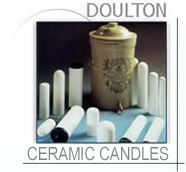
Sterasyl™ Candle |
Features |
|
|
 |
Sterasyl candles |
||
|
The Doulton Sterasyl is a highly efficient ceramic micro filter
which provides genuine sub micron filtration of drinking water. Sterasyl is manufactured with the highly consistent and controlled pore structure necessary to remove a wide range of water borne contaminants over the life of the candle. |
In addition to fine particulate matter, bacteria, cysts and turbidity are removed to a high level of efficiency. The incorporation of silver locked within the ceramic structure inhibits the growth of bacteria and gives each candle enhanced bacteriostatic and self sterilizing properties for safe handling and cleaning. |
|
Natural water filter technology - Sterasyl membranes
Most chemical contaminants can be reduces by the
means of a carbon filter (GAC, compressed or extruded block form filters).
Activated carbon filters are not to be relied on virus and bacteria reduction
in fact, if not changed often they can become a breeding ground for bacteria.
While iodine is still the most effective chemical treatment against virus
and bacteria however it is virtually useless against protozoa like amoebae,
giardia and cryptosporidium. If ingested over an extended period of time it
can be harmful to your health. Chlorine is used in many countries for the
treatment of drinking water. It is a known fact that chlorine will react with
organic matter in the water to form the cancer causing thihalomethanes (THM's).
Just like iodine chlorine is not effective in killing protozoa. They will
both decompose quickly and can not offer a long term protection.